So “Untitled” (Go-Go Dancing Platform), 1991, is unique, but it is not the only one. Now that it has sold “a serious hold” and a $US16m asking price, let’s take a look at the six [!] related works Felix Gonzalez-Torres made. And then decided were not works after all. What are they, where are they, and what is to be done with them?
Category: Uncategorized
All In A Day’s Work
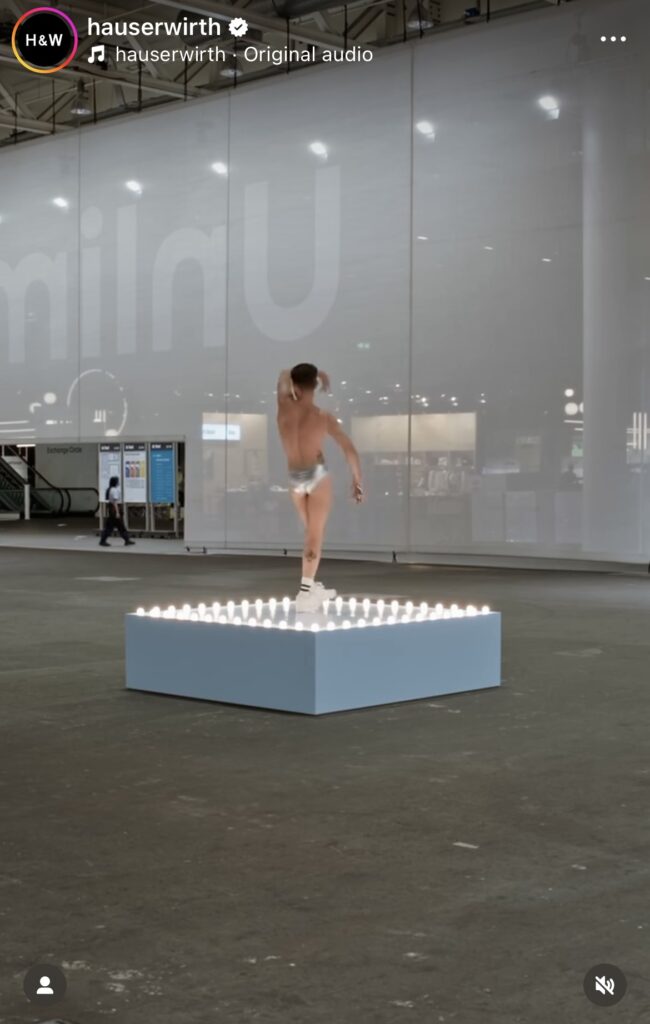
Hauser & Wirth showing Felix Gonzalez-Torres’ “Untitled” (Go-Go Dancing Platform) at Art Basel Unlimited this week. Seeing a video on H&W’s insta of the dancer hopping off the platform and heading out of the halle, accompanied, like a Disneyland character, by a handler, reminds me of artist Pierre Bal-Blanc’s 1992 video work, Employment Contract.
Bal-Blanc was a go-go dancer for the 1992 installation of Felix’s work at the Kunstverein Hamburg, for a show called “Ethics and Aesthetics in times of AIDS.” Employment Contract is a wordless slice of Bal-Blanc’s life that happens to have a brief go-go dancing stint in the middle of it.
One of the tenets of “Untitled” (Go-Go Dancing Platform), reaffirmed just a couple of weeks ago when the Felix Gonzalez-Torres Foundation published an in-process version of core tenets for the work, is that the dancer’s schedule is their own, and it is undisclosed. The dancer chooses whether to share their schedule with the exhibitor, and the exhibitor is to take care not to disclose it, and to provide adequate accomodations for the dancer to go about their business. From the viewing, and even the exhibiting standpoint, this work of Felix’s entails a high degree of uncertainty, and a very low probability at any one moment of there being a dancer dancing.

Bal-Blanc turns this sense of expectation entirely inside out. The video camera tracking him as he jogs through the streets of Hamburg gives no hint at all of what is to come; he’s just a guy, jogging, in jorts. The surreal absurdity of him walking into a museum, unlocking a supply closet, stripping down [to silver and black briefs, a kludgey two-tone outfit that would not pass muster with the Core Tenets crowd], and grooving in an empty gallery for several minutes, defies narrative logic. And yet he goes right on with it, and back out of the museum. All in a day’s work.
This question of context and expectation is one of the perennial sources of power for Felix’s work, especially this one. Encountering a go-go dancer in a museum might feel as disorienting as a pile of candy you can eat from. More than 30 years on, Hauser & Wirth’s instagram comments are somehow still full of people still confused or contemptuous of this work as art. And while art world folks have certainly consumed and processed Felix’s work fully, seeing this piece, from this gallery, at an art fair, the least wild thing about it is the dancer.
[next day update]: indeed, it looks like the Core Tenets got updated just in time, because the work that had been on “permanent loan” to the Museum St. Gallen is for sale by the Swiss collectors who’ve owned it all along. Donald Judd would not be surprised. It does make me want to take a new look at the five go-dancing platforms and lighted pedestals listed in the “non-works” section of the CR.
The Art Of Endangered America

Look, it was already weird to have one nickel for every hanging endangered sea creature chair sculpture South African white guy Porky Hefer made for the Leo DiCaprio Foundation to show at Design Miami in 2018 auctioned my Millea Bros. that turned out to be from the asset liquidation portion of client funds-spending art adviser Lisa Schiff’s bankruptcy proceedings. So the very possibility that we might be at two nickels now is off the charts.
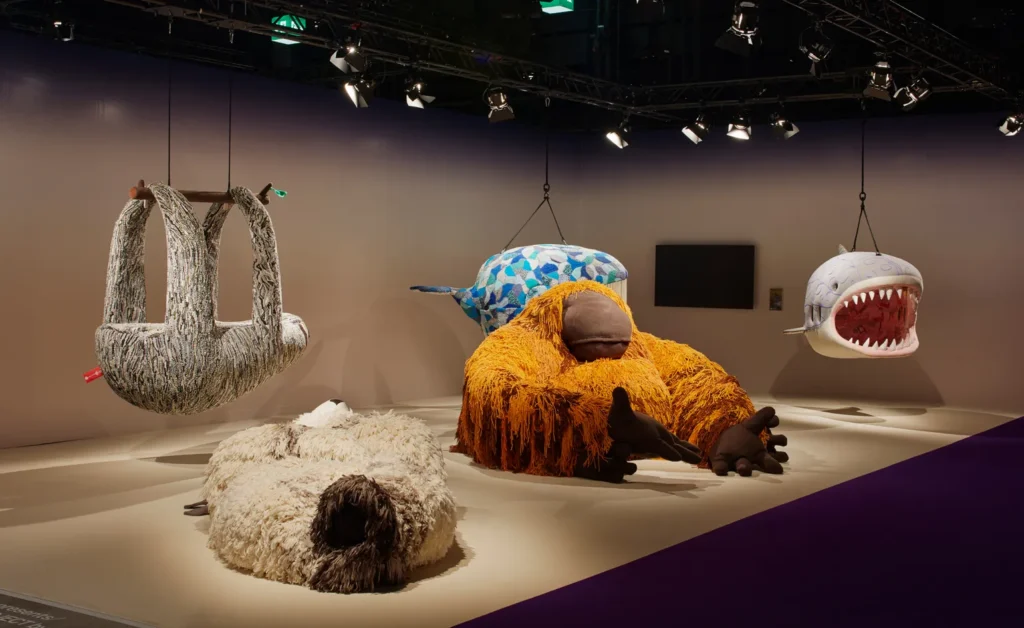
And yet, there it was, hanging right in front of us—and behind the Endangered Orangutan Lounge Chair. Casual observers may think this Endangered Blue Whale Hanging Chair is just an Endagered Shark Hanging Chair with a slipcover. Connoisseurs will see it is covered in recycled t-shirt fabric handwoven to look and feel like your grandma’s bathmat. And conservators will note that the baleen curtain made of strings of beads are, according to the condition report, experiencing “active bead loss.” But honestly, who among us wouldn’t want to just curl up in the mouth of a whale for a few days? It worked great for Jonah. Eventually.

Also at Millea Bros [again] is another lot that I think must have come from Schiff: Sterling Ruby’s acid-washed denim flag, made in 2015 as a benefit edition for the Chinati Foundation. Is there any artwork that captures the moment better than an American flag ghost, with its estimate slashed in half since February, with the proceeds going to pay back some collector who got fleeced on the sale of an Adrian Ghenie painting?
In a way, it’s too bad it’s all being liquidated, because these two pieces—and Schiff’s art collection generally—are the fruit of her life as much as her crimes. They’re superlative examples of the kind of art that piles up along the way when you travel the circuit of art fairs, galas, and opening dinners. Fundraising editions and leftover PR pieces, artworks donated to benefit auctions, gift bag swag, and kickback pieces bought on heavy discount from the galleries where you bring your whales. All accumulated in the service of people with actual wealth—for whom the entire system exists—with their expropriated money.

Maybe all Schiff’s works could have been kept together as a more significant, cautionary gesamtkunstwerkdokument, like how Danh Vo turned all Martin Wong’s tchotchkes into an installation so it could be preserved—and acquired. A Schiff Study Collection would be a snapshot of this frenzied moment, now obviously over. But that would have required much more adventurousness on the part of her collector/investor/client/creditor/victims, who, never forget, were most interested in flipping Adrian Ghenie paintings.
Finally Someone Read The Cady Noland Book [SPOILERS: It’s US]
Whenever I wonder why no one has ever reviewed or analyzed Cady Noland’s 2021 monograph, The Clip-On Method, I wonder if I’m the guy in the hot dog costume or the guy in the color-coordinated suit. I mean, I’ve read both volumes, and refer to them regularly for info and images, but I’ve never written about them, or what they contain, or what it means, and what it tells us about Noland and her practice and the world she sees.
Well, someone finally did, and the results are bleak as hell.

Craig Garrett’s Feb. 11 Darkforum essay, “On Artists, Entrepreneurs, and Psychopaths,” is subtitled, “Cady Noland predicted all of this.” And I fear he’s absolutely right.
Garrett takes a long, close look at Noland’s work, but also a close read of her texts. He begins with her signature 1987/1992 essay on our culture of the psychopath, “Towards a Metalanguage of Evil,” which has been namechecked for years without, apparently, sinking in. But he then goes deep into the essays and papers Noland included in The Clip-On Method, key texts by sociologists Stephen N. Butler and Ethel Spector Person.
[brb gotta run to a lecture, but the Glenstone Noland exhibition closes tomorrow, so get going.]
Dune Bible 4 Calling Spice DAO 2

Nothing quite captured the hopes, dreams, ambition, and stupidity of the crypto moment like the 2021 acquisition by Dune DAO [aka Spice DAO] of Jodorowsky’s Dune Bible for EUR 2.67 million, more than 100x its estimate.
I declared a Facsimile Object exclusively for governance tokenholders of Spice DAO, and never heard or thought about it again. Until now.
The Spice DAO epic involved Copy Number 5 of the Dune Bible, a nearly 300-page art and concept octavo, privately published in 1975. When it was sold in November 2021, Christie’s Paris surmised that there were likely only 10 to 20 copies produced, and only a fraction survived. Given its rarity, it was expected to sell for EUR25-35,000.
Now Copy Number 4 has appeared in an online auction at Christie’s London, with an estimate of GBP250-350,000. The way this price is at once a 90% discount and a 1000% markup really captures the lost surrealist magnificence of the Jodorowsky Dune vision. But the true magnificence comes from noting how Christie’s both copies large chunks of the 2021 lot essay, while assiduously not mentioning the previous sale, or indeed the production or existence of any other copies of the book.
12 Dec 2024, Lot 10 | The Dune Bible, est GBP250-350,000 [update: sold for a bid of GBP220,000, or 277,200 with premium] [christies]
22 Nov 2021, Lot 116 | Herbert, Jodorowsky, Giraud, Dune [christies]
Related: Spice DAO Facsimile Object (S1), 2022
Jasper Johns Little Guys for Leo
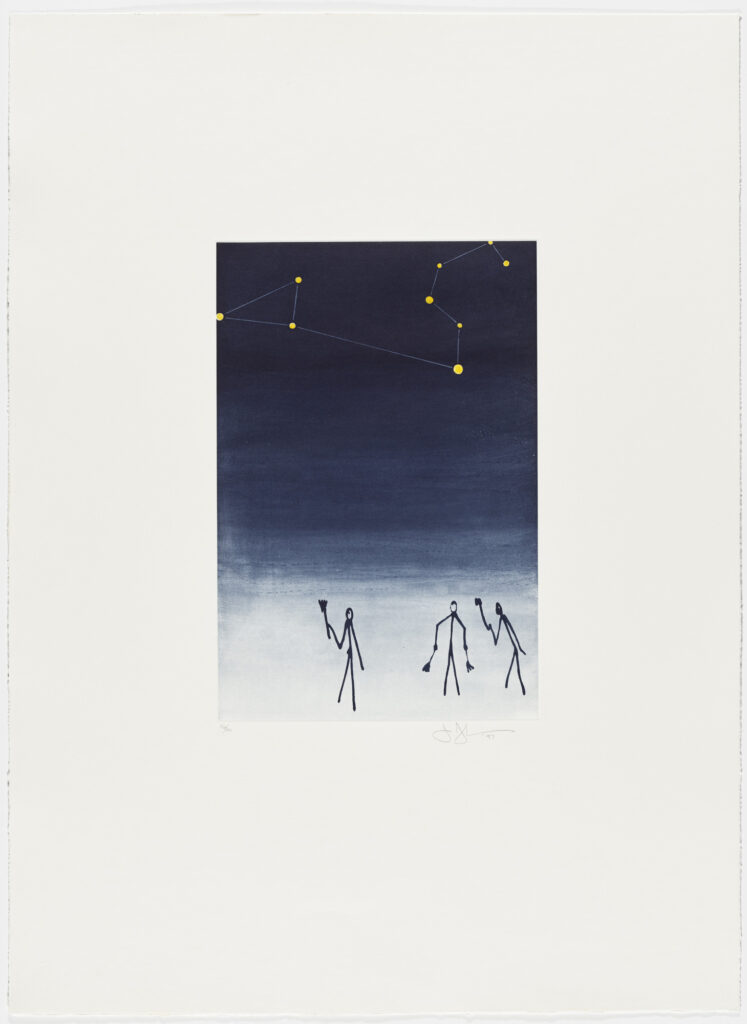
While looking something else up at the Philadelphia Museum, I realized I’d missed a major appearance of the three stick figures I call Jasper Johns’ little guys: they make their astronomical—or astrological—debut in a print created in 1997 for Leo Castelli’s 90th birthday.
It was published by Jean-Christophe Castelli in a portfolio, and so wasn’t printed by Johns’s two major print foundries, Gemini GEL and ULAE, so I missed it in my survey. But it does really capture the way Johns expanded the ways he put them to work in his pictures. Beyond their function in his composition and scale, they also start to imply their own narrative, whether in a picture or as its audience.
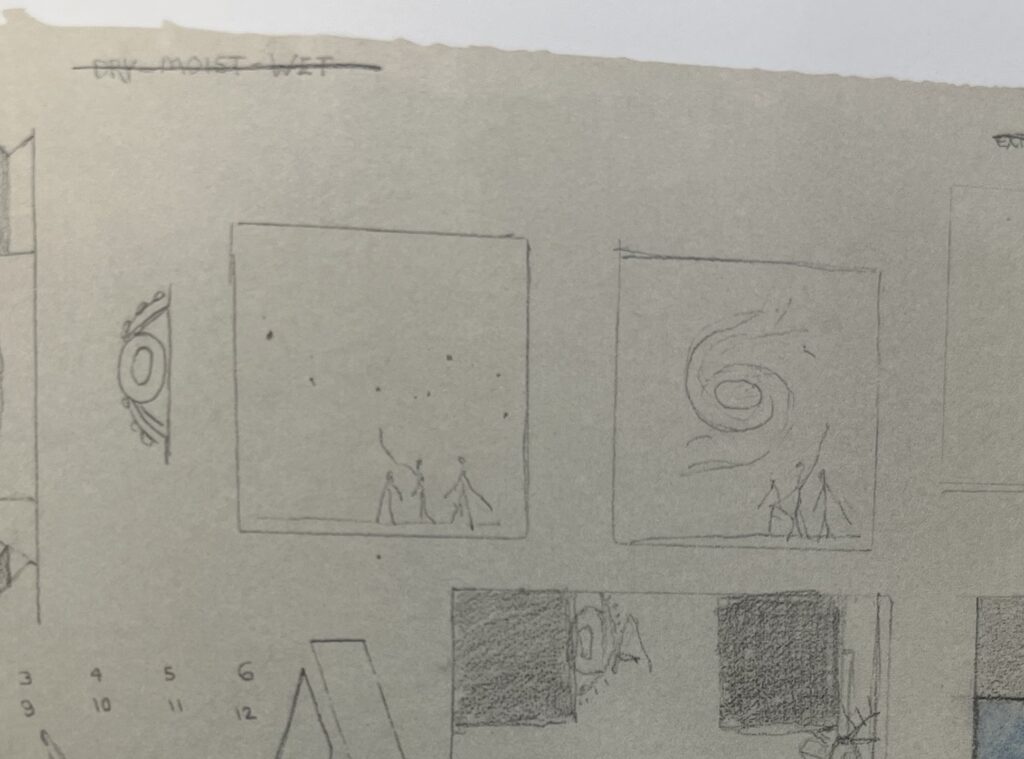
The idea of these stick figures under a night sky seems to first appear in 1997, and it would reappear often as Johns incorporated more astronomical imagery into his work. It really does give these little guys a primordial vibe, like they were here before us all.
Of course, while the sketch above has them looking at the Big Dipper or a spiral galaxy, in Leo from the Leo…, the little guys are looking at the constellation Leo. [Or most of it; the line that forms the lion’s back is missing.] Which maybe did not matter so much; Leo Castelli, born September 4th, was a Virgo.
[next day update: on bluesky Peter Huestis points to Sketch for Leo, a 1997 work on mylar, in the National Gallery. This is not in the drawings CR, I believe, but it’s perfect. It’s described as “charcoal transfer,” which I do not understand. It is not in reverse, so it is at least one step removed from the creation of the printing plates.]

Previously: Jasper Johns’ Little Guys
Jasper Johns’ Little Guys: Origins
Utopian Benches
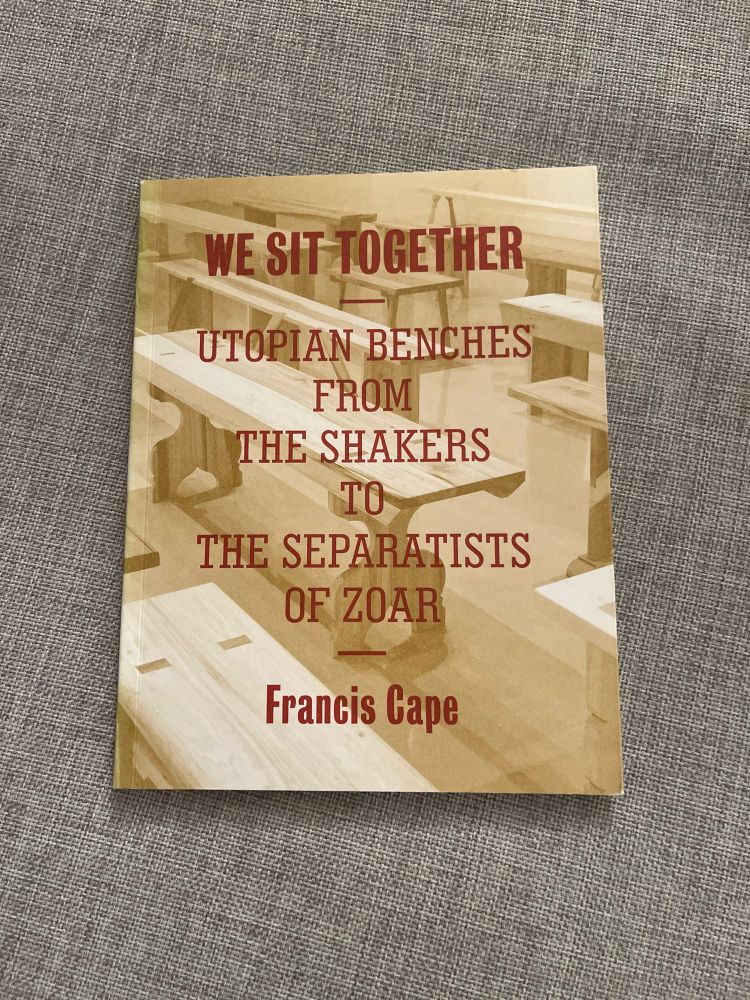
I was surprised to have never heard of a book Andrew Russeth just called, “one of the great art books of this century.” Now I am enthralled with Francis Cape’s project, book, and exhibition of benches from America’s utopian societies.
Cape had begun researching, documenting, and reproducing examples of historical benches from several utopian communities in 2010, when Richard Torchia of Arcadia University learned of the project and proposed an exhibition.
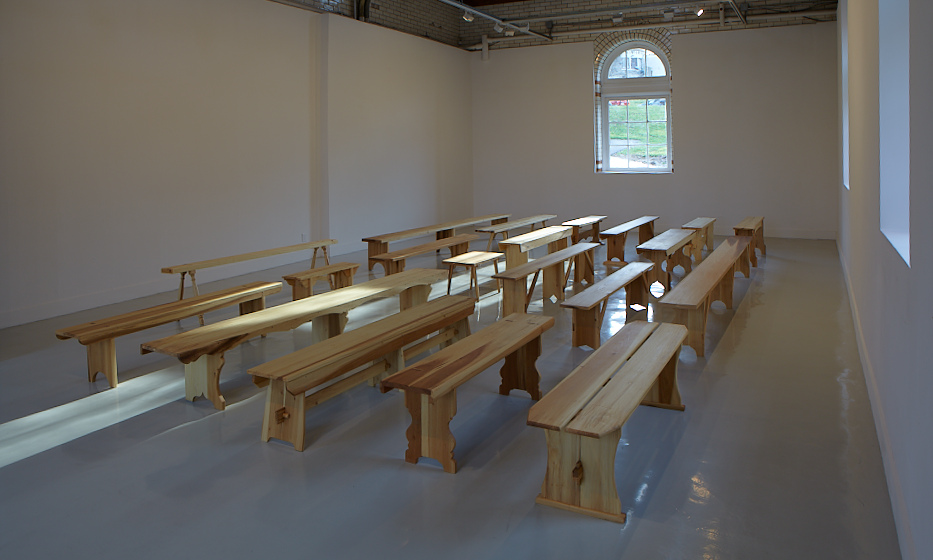
Bomb Magazine published Rachel Reese’s interview with Cape, Torchia, and Daniel Fuller of the ICA at Maine College of Art, where the exhibition traveled after Arcadia:
FC: I was and am interested in the intent the communes share, rather than their differences. They share [an emphasis on] communal living, and with that, they chose to value sharing over individual profit or pleasure. This required a degree of separation from the mainstream, so another thing [they have] in common is their setting themselves apart physically as well as in intent from that mainstream.
As to the transformative moment, it was more the visible moment in an ongoing transformative time. It began when Bush was re-elected in 2004, and I found I could not go on making art about art. The Bush White House’s use of language to conceal rather than to reveal led me reject all falsehood: false wood in the form of the mdf I had been using; cover ups in the form of painting; and most of all, illusion. I was talking with a colleague whose thesis is that artists have found illusion to be anathema since the early twentieth century. I guess I’m a late starter.
So for the benches to be real, they had to be sat upon . . . what better way [for them to be used] than to be shared while talking about sharing?
Utopian Benches opened in 2012, and was accompanied by a small, now seemingly-unfindable publication, we sit on the same bench, a precursor to We Sit Together [published by Princeton Architectural Press in 2013], that explained each bench and the community that created and used it.
Francis Cape: Utopian Benches [arcadia.edu]
Utopian Benches: Francis Cape, Richard Torchia, and Daniel Fuller [bombmagazine]
Marsden Hartley, Fig Tree, 1926-27

Marsden Hartley moved from Vence to Aix-en-Provence in 1926, at the invitation of the Kuntzes, and set to working in Cezanne’s old studio.
According to the chronology in Elizabeth Mankin Kornhauser’s 2003 retrospective, which originated at the Wadsworth Atheneum, this is when Hartley began working on Fig Tree.
The Google Books preview does not include the text about Fig Tree, but earlier texts seem to date it earlier, to 1924, when Hartley was in New Mexico. I will need to find out more about this buck wild painting, which seems to have nothing to do with channeling Cezanne.
Dead Artists: Collect’em All?
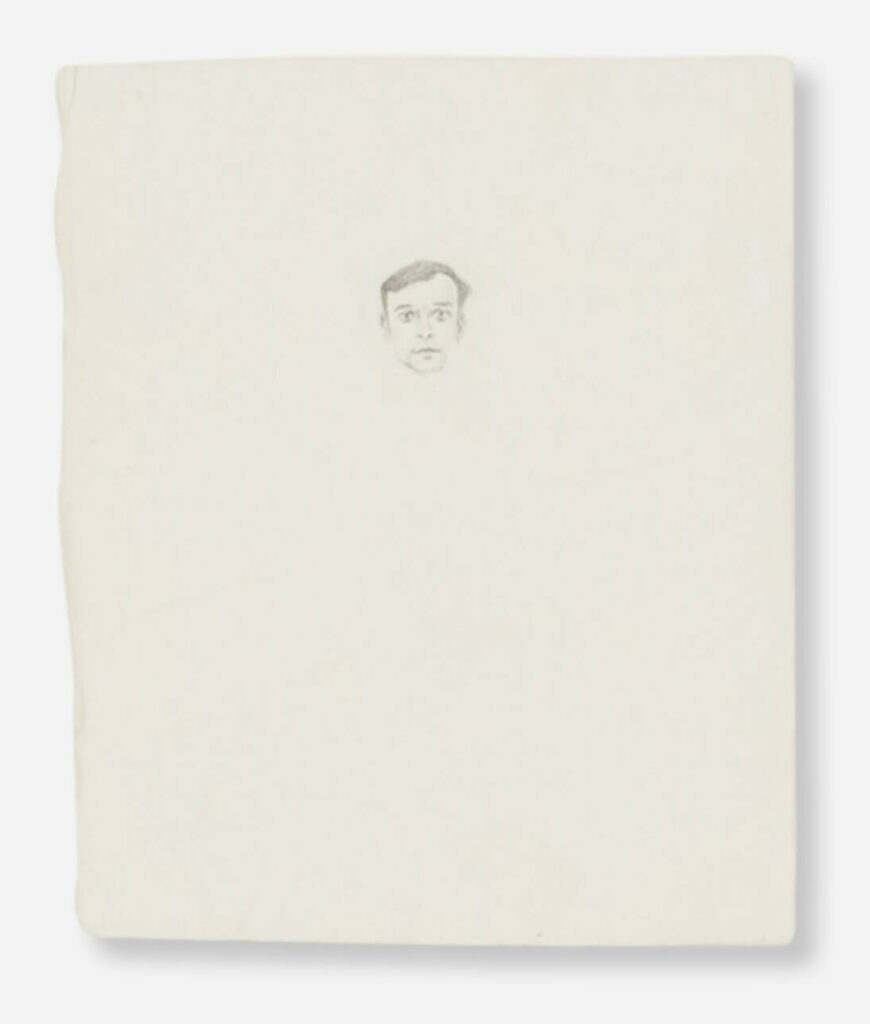
Eventually, every artist will be a dead artist, but so far only a select few have been included in Benjamin Cottam’s Dead Artists Series. Done in silverpoint on a fine little card, the exquisitely ghostly little portraits are only the size of a fingernail.
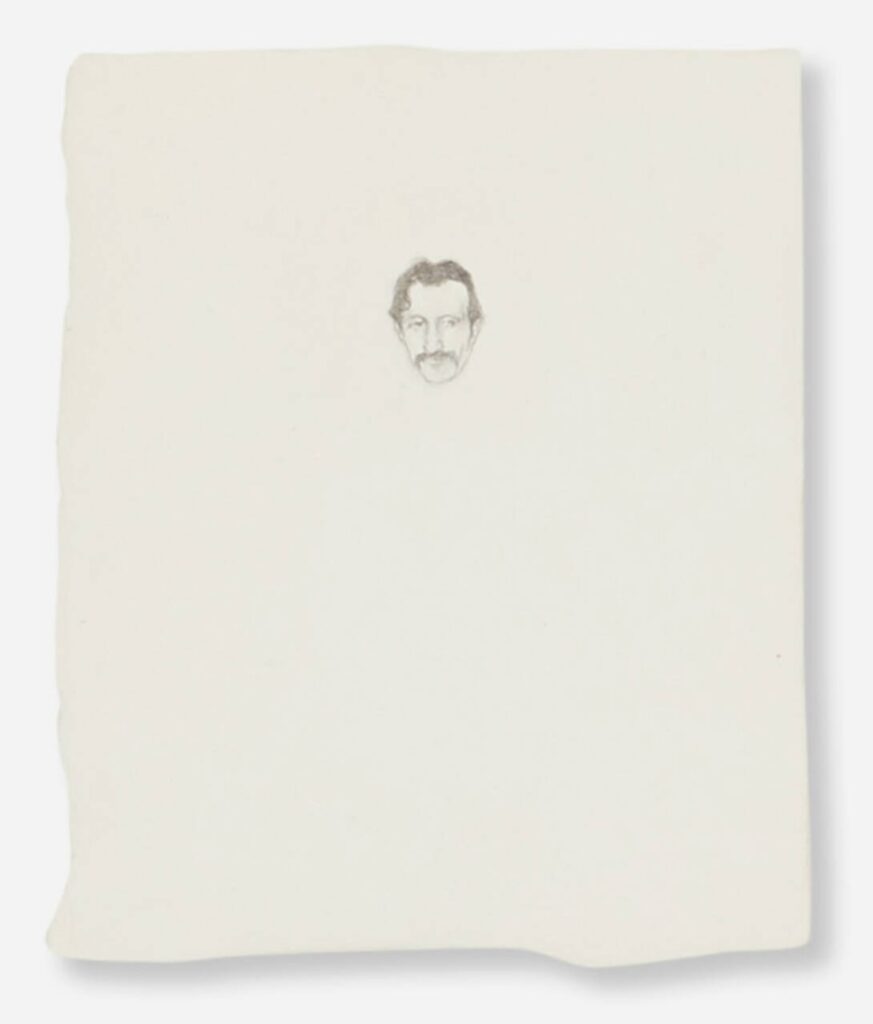
It feels like these two, Yves Klein and Arshile Gorky, fall into an exceptional category: artists whose deaths become a significant element of their art historical narrative.
Maybe that distinction is just me. Back in the day, in the thick of Cottam’s project, we got Andy Warhol, Robert Smithson, and Eva Hesse. Looking through some of the other Dead Artists in the series, there are certainly plenty whose main qualification does seem to be that they were dead. [A lot of those are also just faces in a smudgy haze, with an even eerier vibe than these disembodied heads.]
Another criteria, though might be the availability of a suitable reference photo; when I asked the artist about a Felix Gonzalez-Torres, he looked around and the very few Felix pictures around at the time, and said it wouldn’t work.
So yeah, we have some of these, we love them, and these feel right in sync with those. So am I a dope for hyping them before scoring them? I guess I’d also be happy to see them spread around. Too may Dead Artists in one place might raise suspicions.
27 Sept 2024, Lot 326: Benjamin Cottam, Yves Klein & Arshile Gorky (Dead Artists), 2002-03, est. $1,000-1,500 [update: sold nicely, not to me, enjoy!] [ragoarts]
Dead Artists [benjamincottam]
They Have Not Found The Magic Prism
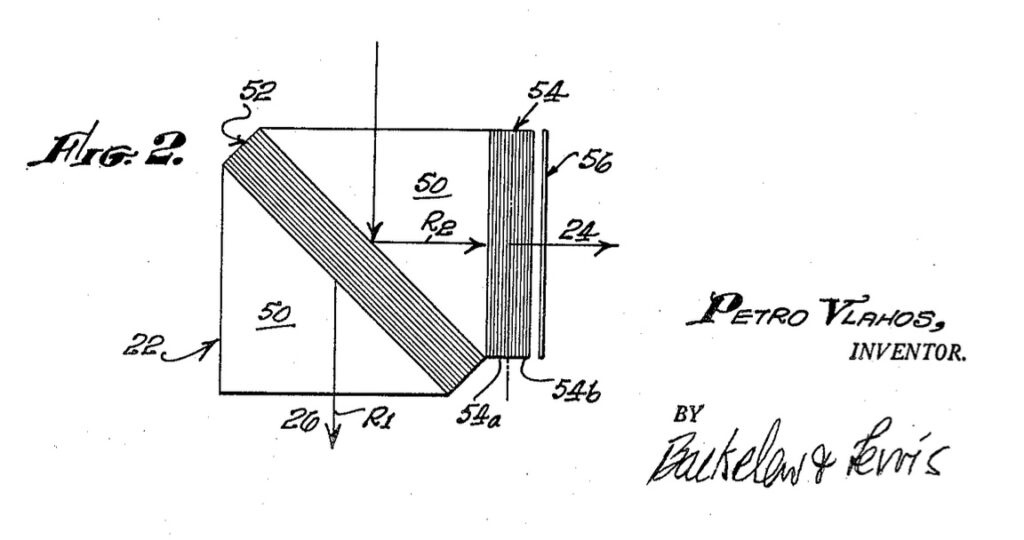
Before there was bluescreen or greenscreen, there was yellowscreen, and it was better.

In the 1950s Petro Vlahos created an in-camera, sodium vapor process which filmed actors lit frontally with white light, against a monochrome backdrop, backlit by yellow sodium vapor lamps, using a beam splitting prism that recorded the color image and its monochromatic mask simultaneously on two reels of film. It is basically a dichroic version of Technicolor, invented by Wadsworth E. Pohl, which used prisms to split an image into three color-separated frames.
Continue reading “They Have Not Found The Magic Prism”Glenn Ligon: Music And The Stenciled Word
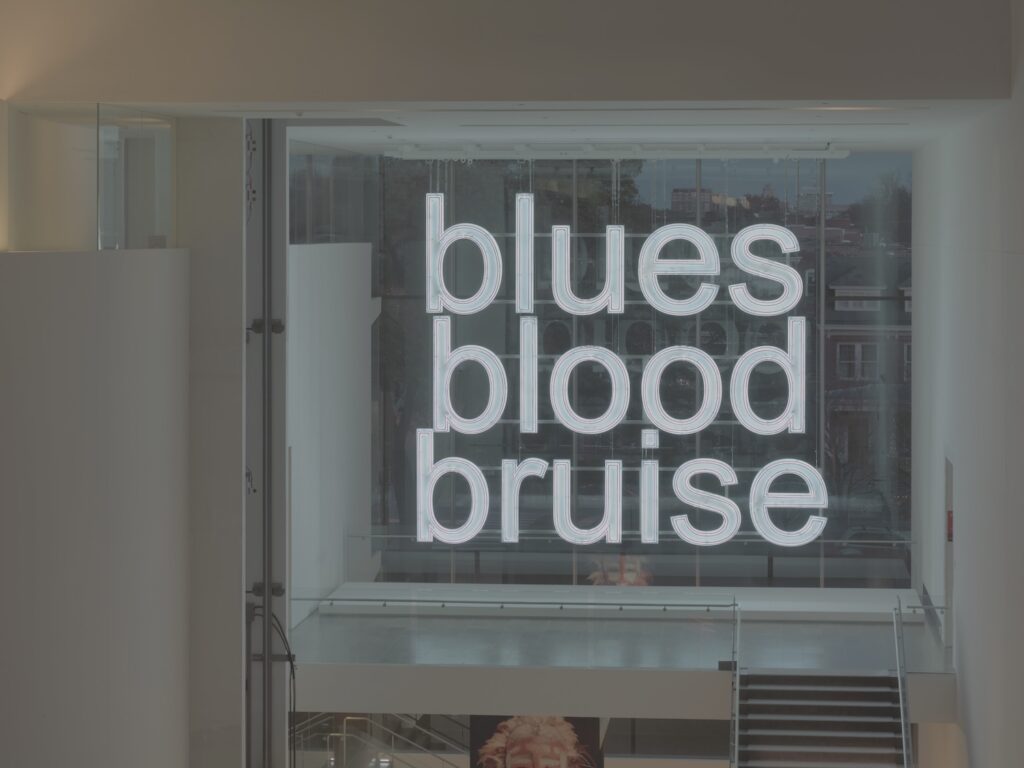
I thought he might be talking about the new collection of writings and interviews that just dropped, and which I’m about a third of the way through, but no. Glenn Ligon’s conversation with Francesca Gavin on NTS.Live was mostly about music. And it turns out to be an unexpectedly interesting vector for his work.
The three pieces they discuss and play, by Steve Reich, Julius Eastman, and Jason Moran, are all bangers of their kind. No spoilers, but Ligon’s made work related to a Reich text piece [above]; Moran scored a Ligon film, and it turns out Ligon and Eastman will be in a two-person show at 52 Walker in January.
Rough Version w/Glenn Ligon, 27.08.2024 [nts.live]
Buy Glenn Ligon: Distinguishing Piss From Rain; Writings and Interviews [hauserwirth, here’s the book trailer, btw]
Previously, related: NTS is also where Mark Leckey has a monthly show, new episode Sept. 3rd!
On And Beyond Sol LeWitt’s Other Memorials
This just in from Our Correspondent In Berlin: the recent blog post about Sol LeWitt’s Black Form — Memorial to the Missing Jews (1987/89) is as incomplete as it was unexpected. Let’s go in chronological order, and from what should have been most obvious.

It is not enough to site the 1987 sculpture in the context of a Germany—actually Germanies—that had yet to address the issue of memorials or counter-memorials to the Holocaust. Or even to note—which I didn’t—that the 1989 re-creation of Black Form in Hamburg was not only larger, but happened just as the Berlin Wall was taken down. And of course, Black Form has existed in Hamburg ever since.
What most needs correcting is the context of LeWitt’s statement, “This was the only political art that I made and the only political thing about it was the title, but I thought I owed it to the Germans – and the Jews – to make one comment.” And the perception of exceptionalism it gave to the Skulptur Projekte, and the constraint it put on the political and memorializing element of LeWitt’s work.
Because that LeWitt quote was from 2000. And while it may have been true that Black Form was the only political art he made to that point, it was not the last, either for the Germans or the Jews. And those later memorials were very much related to Black Form, and not just because of their titles.
Continue reading “On And Beyond Sol LeWitt’s Other Memorials”Apkullacore
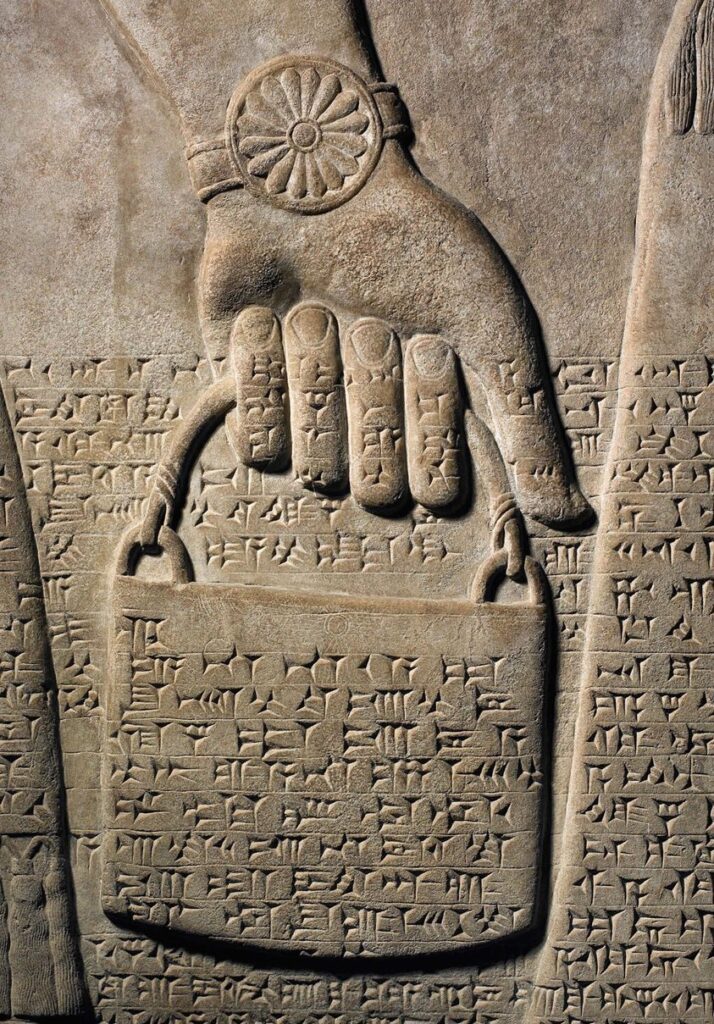
The Walters Museum of Art translates Apkallu as a “winged genius”; other museums which have wall panels from the palace of King Ashurnasirpal II describe Apkallu as a “sage,” or a “genie.” These ripped, winged humanoid figures stood at the entrance of doorways in the palace, offering blessings or protection to passersby with a pine cone dipped into a small bucket of anointing liquid.
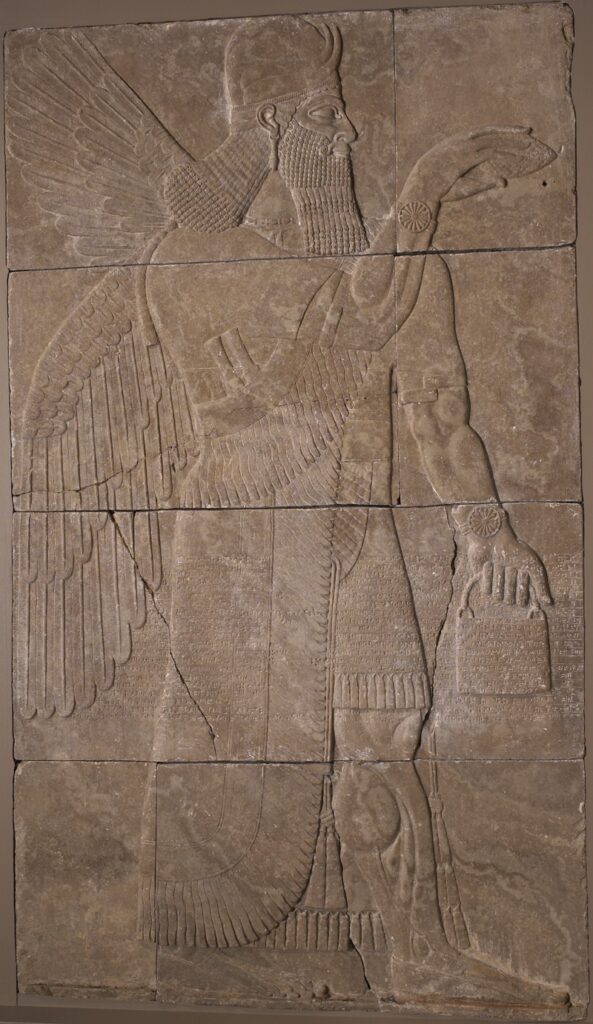
There is obviously much that can be said about Apkulla style: the feathered or fishskin cloaks; the fringed kilts; the beards, the workout, the armbands; the daggers; the horned diadems; the earrings; the rosette-covered wristbands. For starters, let’s just look at the bucket, or as Reddit is fond of calling it, the Handbag of the Gods.
Continue reading “Apkullacore”was gonna post about some building i saw on insta, but then i got on my laptop and saw more pics of it, and it looks like crap, so shoutout to the photographer who found one angle for it, i guess.
Death By Rivet Gun
From Sag Harbor to Monaco to Linz to Cologne to megagallery Los Angeles, the outlook of art world is pretty f’ing dire. Peoples’ critical faculties are failing them. But maybe that just vibes with the rest of the world rn.
five minutes later update: I just read the sentence, “An exceptional team led by Jeff Katzenberg springs into action to produce five weeks of riveting ‘content’ leading up to the Convention…
“America is riveted.”
